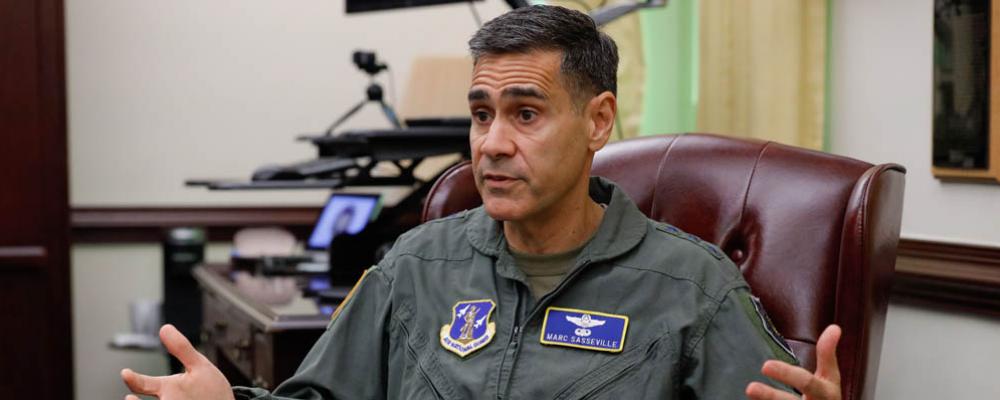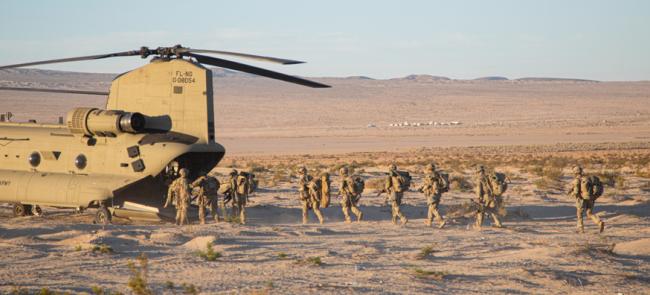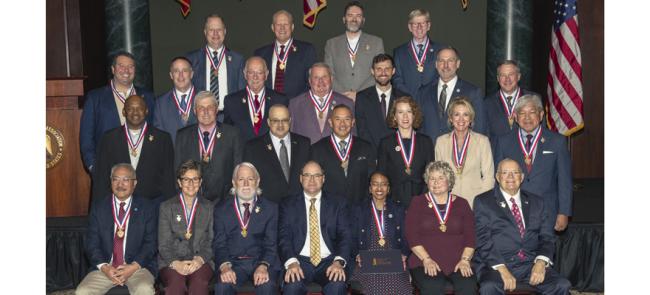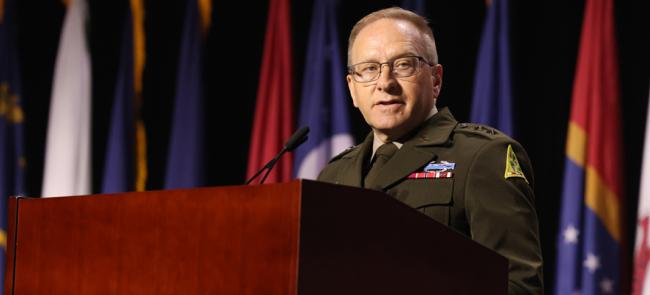
A Conversation with Lt. Gen. Marc H. Sasseville
A painting in Lt. Gen. Marc H. Sasseville's Pentagon office depicts a view few witnessed on the morning of Sept. 11, 2001. Painted by artist Gil Cohen, it shows an F-16 pilot looking down at a burning Pentagon, minutes after American Airlines Flight 77 slammed into the building.
Sasseville, then a lieutenant colonel with the District of Columbia Air National Guard, had a similar perspective that morning. He was one of four F-16 pilots over Washington, D.C., assigned to find and prevent United Airlines Flight 93 from reaching the nation’s capital, even if that meant ramming the airliner. He and his wingman had no missiles at the time.
Now the National Guard’s No. 2 officer, Sasseville is looking back on the Guard’s role in responding to the attacks and the force has evolved into the operational reserve it is today.
He sat down and spoke with NATIONAL GUARD earlier this summer, ahead of the 20th anniversary of the Sept. 11 attacks.
Let’s start with the morning of September 11th. Can you walk us through that day, from your perspective?
Before I really do, I just want to open with how proud I am not only of my unit’s response, the 113th Wing, but the D.C. National Guard and the National Guard in its entirety on the responses to 9/11. We were one small part of the entire DoD response, but in the end, I’m especially happy looking back on it now that we didn’t make a bad situation worse by hurting somebody or one of our own or somebody else on the ground.
Obviously 20 years later, you look at things quite a bit differently, and I’m very happy with the appropriate response. For that day [9/11], my unit had just come back from a flag exercise in Nevada. This is the equivalent of a NTC [National Training Center] rotation in Army terms.
We were already flying a routine schedule when things started to unfold. So we saw the TV – that was our initial source of information. We started making phone calls to people we knew, agencies we knew. As we got more and more information, we realized the severity of the situation, and started taking action.
We were in communication with a White House [Joint Operations Center], as we were watching the [World Trade Center] towers get hit and the Pentagon get hit. We knew we had to do something.
One of the three pilots, [Major] Billy Hutchison, took off and went up the river to comply with a request. My wingman [First Lieutenant Heather Penney] and I also took off in that direction.
We didn’t see anything. We didn’t know at that time that [United] Flight 93 had already impacted the ground. Rest their souls. After that, it was just a continuous 24/7 combat air patrol over the nation’s capital.
It didn’t take us long to realize that we were under attack as a nation. It did take us a little bit longer to realize that this was going to be a pivotal moment in the National Guard’s transition to an operational force. That transition had really started earlier in the ‘90s. I think. As a nation, we had gotten to the point where we saw the need for increased participation from the reserve component. This just accelerated that transformation.
Were you already at the wing that morning when you started seeing the images from New York on TV?
Yes, we were. It was just basically a normal Tuesday morning. We had a normal series of meetings, and that’s really how the day unfolded. We were planning that week’s activities. We had just come back from a deployment, we were getting ready for future activities.
But it was anything but normal after the planes hit. How did you process what was happening and the role you would potentially play in protecting the Nation’s Capital?
It was kind of difficult to understand and process all the information. As I mentioned, the evolution of the National Guard into operational activities was developing. So we brought that mindset to the environment. As the attacks were going on, and as we were watching the chaos unfold inside of Washington, D.C., it became more and more apparent this was a transformational moment for the country and really the globe. That really ushered in this new era for the National Guard to being an operational reserve with strategic depth. That’s how we’ve treated our development since then and we expect to maintain that posture into the future.
You were given the mission to intercept Flight 93. As you were getting ready to launch, what thoughts were going through your head?
My first and most critical piece of thinking was we needed to get in the air as soon as possible. I had visions of December 7th, 1941 flashing through my head, knowing that we had to have some kind of reaction. Again, I can’t say enough good things about our maintainers getting the airplanes ready. [Master Sergeant] Skip Denman was out there pulling pins on my airplane. We didn’t do our standard ground procedures. It was basically an alert posture that I had done previously on active duty. So I was familiar with how to get an airplane in the air quickly.
Once we got airborne, our challenge would be to actually deal with the threat, which was an airliner. We don’t train to take down airliners. We have trained in the past to look at large bombers from our enemies previously during the Cold War. So I was somewhat familiar with what an approach like that might be, but I was really concerned about how we would take down a civilian airliner: where the weak spots might be; and obviously the ethical and moral implications — we had never seen before and we were trying to understand how to handle that.
And then once you’re airborne, you can see the Pentagon.
Yeah. As soon as we get airborne, we flew up the river searching for something coming down the river. That’s what our tasking was. We didn’t know it was Flight 93 at that time, but we put our radars in the right spot to see if there was an aircraft that was navigating to a potential target by flying down the river — that’s a common navigation technique for pilots flying under visual flight rules. We didn’t see anything, so we turned back around and headed over to the Pentagon. I could see where the airplane had hit. And I could smell some of the smoke that was still rising up thousands of feet from the impact.
Did I think I’d be coming home? I really didn’t know. We had no idea what we were flying into that morning, whether there were going to be more waves of airliners that were seeking out their targets or whether the attack was over. So that sense of the unknown was obviously quite unsettling. At that point, we were in reaction mode, doing what we were trained to do.
How long did you spend in the air that day?
For the first sortie, “Lucky” Penney and I were airborne for about an hour and a half. We landed, got gas, debriefed. By then, we were able to get some of our missiles loaded. The first sortie we didn’t have any missiles loaded. We had a gun with training ammunition on it. The second sortie, where we escorted Air Force One back into the National Capital Region, was about two hours or so.
Can you describe for me the days and weeks that followed and how they might’ve been different from the days and weeks that proceeded?
We were not part of the [North American Aerospace Defense Command] structure at that time. So for the next several months, we flew combat air patrols over Washington, D.C., for 24-hours-a-day, seven-days-a-week. It is not an easy thing to do when you consider the amount of effort that it takes on both the sustainment and the pilot side to make that happen. That really took its toll on the unit. I know a lot of other Guard units around the country were doing the same thing at the same time. It’s what was required at the time — at the time, an appropriate response. At the same time, we also became part of the NORAD structure. We were at the time, a general purpose F-16 unit.
That’s when we transformed into supporting the NORAD environment and the structure that defends the nation. We found ourselves supporting the air defense mission the unit is still doing today. That incident also really cemented in our minds the purpose of the National Guard, which is essentially to fight the nation’s wars; that’s really job No. 1 for us. The investment made in our training allows us to effectively produce that capacity and capability our joint-force partners, our governors and the states can use. So during that timeframe, we saw that significant shift.
And what did that shift look like from your perspective? Did training change, did operations change?
Quite a bit, actually. Some of the people that had joined my unit weren’t ready for the [post 9/11] operational tempo. We saw some people who weren’t comfortable with it and moved on. Since 9/11, just about everybody in our force today have joined or recommitted to serving their country. These are volunteers in the purest sense of the word. They understand what the commitments are, and they understand the risks they’re taking. I couldn’t be prouder of the type of soldiers and airmen we have joining our ranks today. It’s a tremendous value for the nation and a tremendous asset for the nation.
And on a personal level, I would imagine the attacks and the trajectory of the Guard after you’ve changed your career trajectory, too. You came from the active component. What were your expectations of your career from that point, and how did that sort of change with the Guard’s role changing?
I graduated the Air Force Academy in 1985, and my intent was to serve as long as I could. In the mid ‘90s, we saw a shift in the joint force and DoD writ large. The Berlin Wall fell in 1989, Desert Storm was in 1991. Immediately after that, we saw the force structure start to decrease in the U.S. military. So as that structure decreases, taskings were also increasing. That is really where a greater reliance on the reserve component, the National Guard, starts to increase, and we see the pressures in becoming an operational force. So right about then, I had to make a decision, to stay in or get out. I made the decision to try to have the best of both worlds — to have a civilian career with airline and to continue to serve.
However, once 9/11 hit, it became very clear our enemies were intent on harming us and challenging our way of life and the order that we valued.
So that really crystallized for me, my motivation to stay in uniform. I realized I wouldn’t be able to do both things very well. So I opted to focus on the military. We see the same thing for the National Guard writ large; which is increased commitments overseas, increased usage, and certainly a lot of mobilizations, both in the Army National Guard and the Air National Guard over the past two decades.
If you look to the future, it’s not that different from what we’re experiencing now. As a matter of fact, you can make a case that our challenges are increasing just as they have over the past two decades. We have [greater power] competition. We have competitors, we have threats out there that still need to be addressed. An operational National Guard provides the joint force the capacity and the capability it needs — it’s really the best solution for the nation.
Do you think the view of the National Guard has changed over the past 20 years, both within the walls here at the Pentagon and out in the community?
I think it has. If you want to set back the clock 20 years ago, the perception of senior leaders of the National Guard was based on a strategic reserve Cold War construct that the country had built for itself. As we deployed more often that changed significantly. We were used as an operational force, serving shoulder to shoulder with active soldiers and airmen, building relationships and growing up together in the ranks, serving multiple tours. The investment made in the Guard in terms of funding, training, time, effort, training to the same standards, really starting to pay off.
Senior leaders across the board now have a different perspective than senior leaders from 20 years ago. All those investments made into us as an operational reserve, turned into benefits for the communities, where the governors and the adjutants general in the states benefit from a force that’s well-trained, well-equipped and ready to support domestic operations when they’re not deployed to fight the nation’s wars.
Is there any concern that some of those developments within the Guard could be lost or capabilities degraded now that the war in Afghanistan is coming to an end?
That’s a great question. That’s something we need to continually assess, to ensure we preserve these investments our nation has made. How do we continue to leverage the capacity and the capabilities we have placed in the reserve component to help the nation and help the joint force? It’s important we maintain that capability and capacity so we can continue to be an effective operational force. If we don’t participate in meaningful training opportunities, there’s risk of backsliding.
What do you hope to see as the lasting legacy of these past two decades when it comes to the Guard?
When we look back on this 20-year period, I think we’ll see this as a pivotal moment in the evolution of the National Guard. It’s hard for us to see it now, but there have been significant changes to the National Guard in the past 20 years. And if you look backwards to the past century, at the beginning of the 20th century, you can see how we transitioned from an organized militia into the National Guard, where subsequent national defense acts have changed and legislated new approaches. The historians will judge. But, for example, in the past 20 years, our state partnerships have doubled across the globe, right? Now, there are state partnerships between our states and countries that are looking to have a relationship with the United States.
Also, the chief of the Guard Bureau was elevated to a four-star rank and made a member of the Joint Chiefs of Staff within the past 20 years. We have modernized our state headquarters and turn those into joint force headquarters, and that’s across the board. That did not exist pre-9/11. We have joint operation centers in each of those [54 states, territories and D.C.]. Every state now has at least one Civil Support Team, some have two. National Guard Reaction Forces have come online since then as well. So the National Guard has experienced a tremendous evolution, not only to support the warfight, but also to help our allies and partners throughout the globe. It’s benefited our partnerships at the state and local levels while supporting the governors with domestic responses. We’ve also have great interagency relationships with the federal agencies.
That lays the foundation we can build on going into the future, because this is clearly not the end of the National Guard story.
We talked about where you were in your career 20 years ago. Now you’re sitting here in this office as the vice. Can you talk a little bit about what issues you’re focusing on these days? What are you paying particular attention to and what are you trying to accomplish in your current role?
The chief of the National Guard Bureau has four priorities: people, readiness, modernization, and reform. That’s what I spend most of my time working on. I won’t go through all of them, but we can say people are our No. 1 priority, and it’s really up to us to take care of them. The chief [General Daniel R. Hokanson, chief, National Guard Bureau] asked us to stand up, for example, a task force on sexual assault prevention and suicide prevention. We’re spending a lot of time and energy, in line with the Department of Defense, to tackle some of those issues. Diversity and inclusion is also an important focus area — we have to make sure that everybody is treated with respect and dignity across the board. We’ve got a lot of work to do. And we’re building a prevention workforce that will help us achieve some of those objectives.
AT A GLANCE: Lt. Gen. Marc H. Sasseville
BORN: Marc Henrys Sasseville, March 23, 1963 (Wright Patterson Air Force Base, Ohio)
FAMILY: Married with two children
EDUCATION: Air Force Academy, Colorado Springs, Colo., B.S. International Relations, 1985; Embry-Riddle Aeronautical University, Daytona Beach, Fla., M.S. Aeronautical Science, 1996; Air War College, Maxwell Air Force Base, Ala., 2004
COMMISSIONING SOURCE: Air Force Academy
MILITARY SERVICE: Active-component Air Force 1985-1999; District of Columbia Air National Guard 1999-present
PREVIOUS ASSIGNMENTS: Commander, 1st Air Force and Continental U.S. North American Aerospace Defense Command Region, Tyndall Air Force Base, Fla. 2019-2020; Deputy director, Air National Guard, Washington, D.C. 2017-2019; Defense attaché, Turkey, 2014-2016; Commander, 113th Wing, Joint Base Andrews, Md. 2012-2014
OVERSEAS OPERATIONS: Operation Iraqi Freedom
CIVILIAN OCCUPATION: Former commercial airlines pilot with Delta Airlines
ALSO NOTABLE: Command pilot with more than 3,300 flight hours in the T-41, T-37, T-38, F-16, B-747, B-727 and C-38
Source: National Guard Bureau



